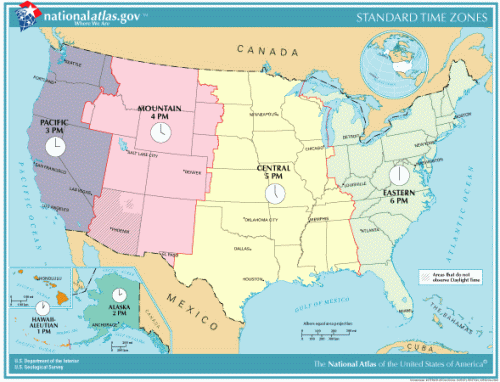We’re in that wonderful time of the year when people are still getting used to Daylight Saving Time (that’s Saving without an “s” and no I don’t know why that bothers me). On Twelve Mile Circle that also means I’m getting an odd little bump in traffic that only happens when the time changes either forward or back.
It’s a traffic pattern I observe on many of my time zone pages. However, it is perhaps most prevalent and best described on Arizona Does Not Recognize Daylight Saving Time. Here’s the latest result:

I found another fascinating anomaly on the United States timezone map as I was contemplating the recent Spring Forward. Maybe you can too. Go ahead, take a look and let the patterns sink in.

I think I’ve probably covered just about every timezone oddity on this map in previous posts but there’s at least one more. Ponder the situation I’m about to describe, but feel free to go back to the map and cheat if you want some assistance: A west coast state bordering the Pacific Ocean has a time zone that’s only one hour different than an east coast state on the Atlantic Ocean. What are the two states?
The Remarkable Answer
The answer is Oregon and Florida, which sounds improbable until one takes a look at the map. Now the answer is probably jumping out in flashing obviousness. Most of Oregon follows Pacific Time but a small chunk of its eastern flank falls with Mountain Time. Conversely, most of Florida follows Eastern Time but the western portion of the panhandle falls within Central Time.
Thus, a person picking up a phone in the town of Vale, in Malheur County, Oregon who wants to call someone in Pensacola, Florida, will only have to worry about a one hour time difference. These two points are nearly 2,500 miles apart and yet have this odd connection because of the double anomaly. If our fictional callers stand just a few miles further apart, the will have to worry about a three hour time difference.
How?
The reason these two small sections of their respective states fall within different time zones has been discussed in previous entries but I’ll provide a brief summary here. Southeastern Oregon has an affinity with Idaho, closer in distance and culture to Boise than to Portland. Conversely, Pensacola has more in common with Mobile than Miami. It’s natural that they don’t follow the general time of their home states.

Leave a Reply